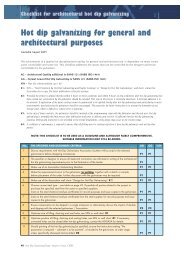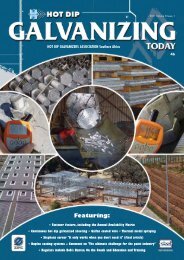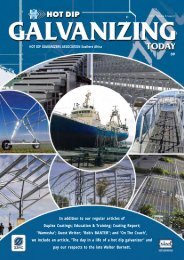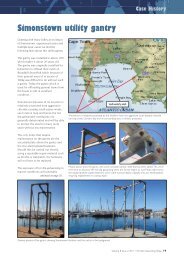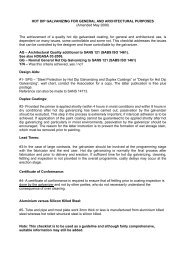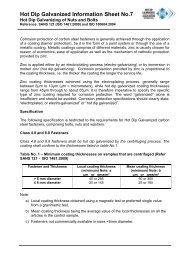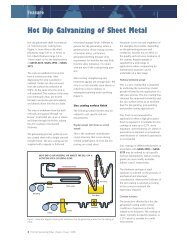Featuring: - hdgasa
Featuring: - hdgasa
Featuring: - hdgasa
Create successful ePaper yourself
Turn your PDF publications into a flip-book with our unique Google optimized e-Paper software.
Walter’s Corner<br />
Walter’s Corner<br />
Corrosion control of threaded articles<br />
The statement that a chain is as<br />
strong as its weakest link can be<br />
appropriately applied in the case of<br />
many corrosion control standards<br />
which are in common use. To<br />
illustrate, a bolted steel structure is<br />
provided with a hot dip galvanized<br />
zinc coating with a minimum<br />
thickness of 85µm of zinc. The<br />
specification calls for “galvanized”<br />
bolts so the supplier takes the easy<br />
way out and orders so called “electrogalvanized”<br />
bolts off the shelf. These<br />
zinc electroplated bolts and nuts are<br />
in all probability coated with a zinc<br />
film of about 6µm compared with a<br />
hot dip galvanized structural fastener<br />
assembly where coating thickness<br />
would be some ten times greater.<br />
Assuming the atmospheric corrosion<br />
rate of zinc in the environment<br />
where the structure is to be erected<br />
is moderately high at 3µm per year,<br />
the life of the coating on the<br />
structural steel before 5% surface<br />
rusting would be about 30 years<br />
whereas that of the coating on the<br />
fasteners would be approximately<br />
two to three years.<br />
This example is by no means<br />
hypothetical. In fact one comes<br />
across it in practice quite frequently.<br />
Extensive research and experimental<br />
work has been undertaken in the<br />
past with a view to ensuring that a<br />
thicker more durable hot dip<br />
galvanized coating can be<br />
satisfactorily applied to bolts, nuts<br />
and other fastening devices without<br />
in anyway reducing the mechanical<br />
properties required from bolted<br />
connections.<br />
Contrary to the view sometimes<br />
expressed, the hot dip galvanizing<br />
process, if correctly applied, will not<br />
cause hydrogen embrittlement of<br />
high strength fasteners, neither does<br />
the increase in tolerance between<br />
bolt and nut thread, which is<br />
required to accommodate the thicker<br />
zinc coating, adversely reduce the<br />
tensioning properties of the bolt and<br />
nut assemblies. This is provided<br />
that the over sizing of nut or<br />
undercutting of bolt threads is<br />
undertaken in accordance with the<br />
approved standard.<br />
Hot dip galvanizing of threaded<br />
components is somewhat specialised<br />
requiring not only specialised<br />
equipment but also the necessary<br />
experience and expertise on the part<br />
of galvanizing personnel.<br />
The majority of threaded articles are<br />
subjected to a centrifuging operation<br />
when withdrawn from the molten<br />
zinc. This is to remove excess zinc<br />
from threaded surfaces.<br />
Centrifuging is perhaps the main<br />
difference between general<br />
galvanizing and the more specialised<br />
coating of bolts and nuts. If it is not<br />
performed by experienced personnel<br />
using efficient centrifuging<br />
equipment, the results obtained can<br />
be unsatisfactory to say the least,<br />
with clogged threads which render<br />
correct assembly of bolts and nuts to<br />
be difficult or even impossible.<br />
In the case of lengthy components<br />
such as stay rods or threaded round<br />
bar, items are passed through an air<br />
ring or the threads are wire brushed<br />
after withdrawal from the molten<br />
zinc and prior to the coating<br />
solidifying.<br />
Tensioning of hot dip galvanized<br />
assemblies is best achieved by<br />
lubricating threads prior to<br />
assembly. This is to avoid gauling of<br />
the relatively thick zinc coating prior<br />
to the required tension being<br />
achieved. The easiest and most<br />
reliable method of precision<br />
tensioning (e.g. with high strength<br />
assemblies) is the turn of the nut<br />
method. This is achieved by first<br />
tensioning either by hand or with a<br />
torque wrench which is set to the<br />
snug tight position, then followed by<br />
a final half or three quarter turn of<br />
the nut whichever is specified. The<br />
results of the turn of the nut<br />
tensioning method are both accurate<br />
and consistent.<br />
The initial cost of hot dip galvanizing<br />
bolts, nuts and washers is for<br />
obvious reasons more than that for<br />
zinc electroplating. On the other<br />
hand, if one considers the cost<br />
effective life of hot dip galvanizing in<br />
most environments, it is<br />
substantially lower in cost than the<br />
normal electroplated zinc coating.<br />
Unfortunately many suppliers will<br />
always take the easy way out by<br />
securing the cheapest product<br />
readily available off the shelf rather<br />
than the most suitable one which<br />
perhaps requires more effort to<br />
secure. In order to avoid ambiguity<br />
it is also important for specifiers to<br />
state what is required in precise<br />
terminology.<br />
One of the best examples of the<br />
successful use of hot dip galvanized<br />
fasteners is the Eskom electrical<br />
transmission tower. Many thousands<br />
of these structures are spread-eagled<br />
throughout the countryside all<br />
assembled and held together with hot<br />
dip galvanized bolts, nuts and<br />
washers. This is one of the reasons<br />
why Eskom’s budgeted maintenance<br />
free life span of 50 years for these<br />
structures is invariably achieved and<br />
frequently surpassed.<br />
For more detailed information<br />
concerning corrosion control of<br />
fastener assemblies, Association<br />
personnel will be very pleased to<br />
discuss with you your specific<br />
problems or requirements.<br />
34 Hot Dip Galvanizing Today Volume 4 Issue 3 2007



